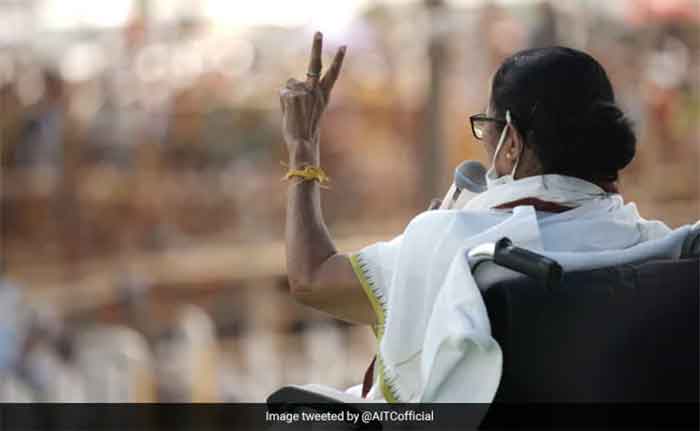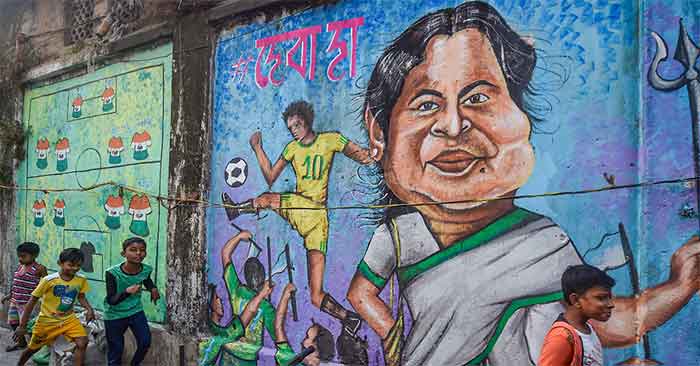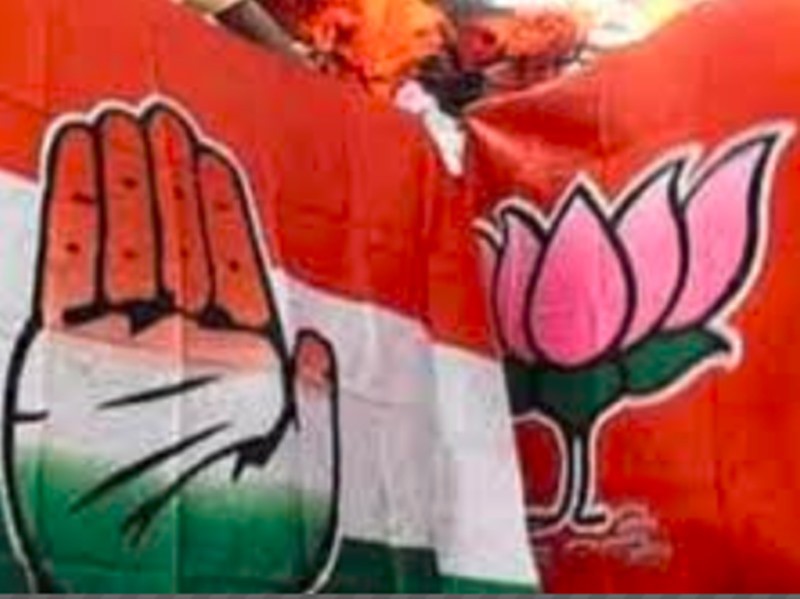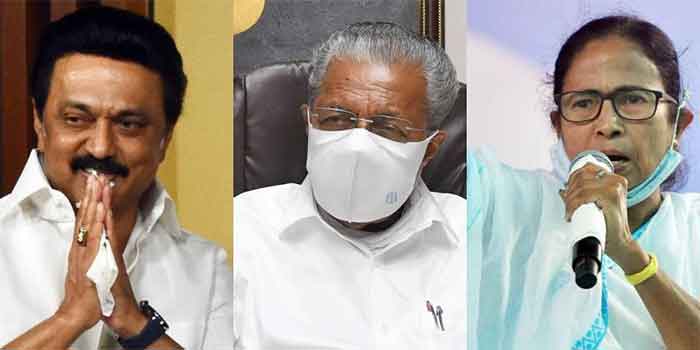
After Mamata Banerjee’s win in the elections in Bengal, a spate of celebratory articles has appeared all over the liberal media saying such things like Bengal rejects communal politics, rejects politics of hate, rejects Hindutva, etc. On the basis of the election, Shoaib Danyal shows his on-ground journalistic skills by discovering that ‘Bengal is, as famously described by political scientist Dwaipayan Bhattacharyya, a “party-society”’, where caste is overshadowed by political parties in the public space. Siddharth Bhatia, who has never been a sanitation worker purely because of his illustrious ancestry, claims not only that ‘Bengalis have no interest in the tenets of the Manusmriti’, already a very tall claim which I am sure Dalit-bahujans would love to hear, but that ‘the essence of Bengaliness’ is completely alien from Hindutva. Jawahar Sircar goes one step further than these two in exhibiting his peacock-like savarna colours (maybe so Modi will also play with him) and actually writes without irony that caste does not mean much to the bhadralok in Bengal who ‘find the business of caste to be quite messy’, cherish ‘education, culture, liberal values and a historic freedom from orthodoxy’, and opened their ‘doors to meritocracy from other castes as well, decades ago, without much fuss’. Nazes Afroz is able to exhibit his Bengali loyalty (in order one supposes to prove he is not a Bangladeshi) by proclaiming ‘Bengali culture has always been critical/sceptical of authority’. Neelanjan Sircar, who should be awarded the Nobel Peace Prize for his discovery, claims to have found the master-key to solving the Hindu-Muslim issue in India—‘Fundamentally, this election showed the power of political appeal based on welfare and gender, and how it may undercut Hindu-Muslim polarization’. Upal Chakrabarti sees TMC’s win as significant ‘not only because it means a strong rejection of a possible saffron Hindutva regime and consequent communal polarisations’ but also because, by some absurd leap of logic only senile communists who converse with the ghosts of Marx and Lenin can make, it shows that ‘The future will no longer just be, taken over by the time of capital’.
The elections surely showed some very heart-warming and hopeful things if everything the articles claim is actually true. But we empiricists, who believe that claims should not be believed because they sound good to jaundiced ears but because they correspond with reality, are left with a few questions. I am not going to go into the romantic picture of caste-free Bengal these over-enthusiastic revolutionaries (enthu-cutlets in today’s lingo) have conjured up out of their radically-educated imaginations because it is so obviously ridiculous. Rather, I am going to focus on the main aspect of the celebration. Since the victory laps are being taken over defeating communal forces, we have to ask if the communal forces have indeed been defeated. But before we judge whether communal forces have been defeated, we have to see who these communal forces are.
According to the articles, Hindutva, represented by BJP and RSS, is the sole and whole communal force in India. Suhas Palshikar, ostrich extraordinaire, writes ‘What has historically distinguished the BJP and continues to distinguish it from all other parties is the project of majoritarianism.’ To make this judgment, Palshikar and others have had to separate good Hindus, who are secular and pro-Muslim, from bad Hindus, who are communal and anti-Muslim. That is, there is one Hindu who is liberal and anti-Hindutva and another Hindu who is orthodox and pro-Hindutva, and there is apparently zameen-asmaan ka fark between the two. Mamata Banerjee going to temples and reciting religious chants in public spaces is okay because she does it with love in her heart for Muslims, while Modi going to temples and saying Jai Shri Ram in his rallies is not okay because he does it out of hatred for Muslims. But, the problem is, even if we believe that a pro-Hindutva Hindu is anti-Muslim while an anti-Hindutva Hindu is pro-Muslim, we still can’t say they are not communal. Both logically and chronologically, the primary aspect of Hinduism is not to be anti-Muslim but to be pro-caste. So, when the secularism of Hindus is judged by how they behave towards Muslims, the point is missed entirely. A Hindu can behave well towards Muslims and still believe in the caste order. In fact, Ambedkar specifically showed that it is false to make a difference between liberal Hindus and orthodox Hindus from an anti-caste perspective because to be a Hindu, whether liberal or orthodox, cannot substantively mean anything except believing in the caste order.
The question then arises, is the belief in caste a communal belief? To be communal in India’s context means to assert the interests of one’s community at the expense of the nation as a whole. In that it divides the nation into warring communities, thus weakening national unity, communalism is seen to be anti-national. The whole point of caste is division of people on the basis of birth into enclosed groups which assert their own interests at the expense of other enclosed groups below them in the caste order. While it can be asserted with some degree of confidence that there are as many nations in India as there are castes, we can say with much more assurance that caste divides India into at least two antagonistic nations—savarna and avarna—whose interests cannot be reconciled till caste is completely annihilated. What can be more communal and anti-national than caste which is the greatest impediment to the formation of a single Indian nation? As Ambedkar said, ‘The castes are anti-national in the first place because they bring about separation in social life. They are anti-national also because they generate jealousy and antipathy between caste and caste.’ Since both liberal Hindus and orthodox Hindus believe in caste, they are both communal.
So, we, who think Hindu and Hindutva are no different from each other in the matter of communalism, are in a bind. If we don’t believe Hindus can be divided into good and bad, if we think all Hindus are bad (whether liberal of orthodox), then we are left to wonder who defeated whom. Is there then no difference between liberal and orthodox Hindus? There is indeed. Liberal Hindus are only different from orthodox Hindus in that they overtly disavow caste to covertly assert it while orthodox Hindus overtly support caste. To put it more succinctly, liberal Hindus are hypocritical about caste while orthodox Hindus aren’t. Instead of seeing the election as a victory over communalism, we are then forced to see it as the victory of a hypocritical communalism over a bare-faced communalism.
At this point, another question can be raised—are hypocritical Hindus not better than bare-faced Hindus and isn’t that enough of a cause to celebrate anyway? There are some who think hypocrisy pays homage to virtue and thus believe that those who recognize virtue but continue to do vice are better than those who do not even recognize virtue but engage in vice as if it is virtue. I don’t much go in for the apologia for hypocrisy myself. In my opinion, it is worse to have hypocritical oppressors who choose to engage in vice when they know, and thus could do, better than to have ignorant oppressors who choose vice because they don’t know, and thus couldn’t do, any better. The ignorant are at least not consciously making a choice to do something bad, they are doing what is good to the best of their knowledge. The hypocrites, on the other hand, choose to be bad people. It is possible to educate the ignorant and make them see the right path and hope that once they know what is right, they will leave their old ways. What can one expect from hypocrites who already know everything? One can’t educate them and expect a better outcome. In their case, there is no hope for a better future.
There is one communalism that hides its activities to appear secular and another that does not hide its activities. I would think it is obvious that it is better to have an enemy whose cards can be seen than an enemy with hidden cards. Would you rather deal with a person who says to your face he cares about you but stabs you as soon as you show him your back, or with a person who comes to your house with a sword and challenges you openly. Granted, both scenarios are terrible, but I think no one can doubt the first scenario is more terrible than the second because there is no conceivable defence in the first scenario while, with some clever manoeuvring and quick action, some form of defence can be made in the second scenario. Orthodox Hindus come with their Manusmriti and order you to follow it. You can refuse their order and duke it out to see who comes out on top. Liberal Hindus, on the other hand, come with Ambedkar’s constitution and figure out devious ways of making it order you to follow Manusmriti, without ever mentioning the Manusmriti. To refuse to follow their orders is shown to be a refusal to follow the constitution and thus legally punishable and anti-Ambedkar. It takes much time and energy, time and energy which are very dear to the masses, to even learn that one is being told to follow the Manusmriti with the use of the constitution by people who are experts at such tricks. In one case, the masses can put up a fight instantly; while in the other case, a whole arduous process of unmasking has to first take place for the fight to even begin, which it inevitably has to at some point anyway.
We can see the rise of the BJP as a direct consequence of the downfall of Congress, of the rejection of Congress for regional parties run by Dalit-bahujans. The BJP replacing liberal Hindus is a win for anti-caste movements as they made Hindus drop hypocrisy and take a more straight-forward line. Hindus couldn’t afford to be hypocritical any longer because they couldn’t support the burden of hypocrisy under the repeated attacks of anti-caste movements. The resources which were being spent on hypocrisy were forced to be diverted elsewhere in the war against anti-caste movements. Communalism didn’t have the wherewithal to spend resources on putting up appearances. India’s modern history bears testimony to the fact that Hindu-Muslim polarization is a direct result of Dalit-bahujan assertion. It is only with Mandal that Mandir is actually able to become a national issue. Conversely, lack of Hindu-Muslim polarization thus shows a lack of Dalit-bahujan assertion. Hindus are willing to remain soft as long as Dalit-bahujans don’t become assertive. As soon as Dalit-bahujans start demanding power, Hindus become hard and pick up their lathis. In Bengal, it is precisely because Dalit-bahujan assertion was so ruthlessly repressed by the Communists that Hindus don’t have to be afraid of it and can afford to remain soft for some more time. The liberal Hindus were so sure that Dalit-bahujans couldn’t win the election in Bengal that they didn’t even float a positive agenda, their primary campaign was ‘No vote to BJP’. They could afford to not ask for votes for themselves because they knew that the defeat of BJP could only mean their victory, since there was no Dalit-bahujan party in contention. In a way then, Mamata Banerjee’s victory is a symptom of the total bhadralok domination of Bengal.
This brings us to why Muslims support liberal-Hindu parties en masse while Dalits-bahujans don’t. It is a symptom of the total Hindu domination of India. Many commentators seem to be stumped by this and even blame the Dalit-bahujans for voting against their own interests. We, who are unable to tell people that they voted wrongly because we don’t know better than them what their interests are, can only try to understand why Dalit-bahujans vote for the BJP. Liberal Hindus can behave well towards Indian Muslims only because they know the Muslims are not in a position to assert themselves and thus are not a threat to Hindu order. In fact, whenever Muslims like Sharjeel Imam do become assertive, liberal Hindus grow rabid and quickly join hands with orthodox Hindus to denounce them. But, since their very survival is threatened, Indian Muslims do not assert themselves all that much and the Muslim masses are not voting according to assertion at all, they are voting for survival. Soft Hinduism kills them less even if it makes them just as poor. Since their survival is not threatened to the same degree, the matter is not of survival for Dalit-bahujans but of assertion. Muslims are not in a position to articulate an alternate vision for India’s future or their future within India, but the Dalits-bahujans are. Unlike Indian Muslims, they are in a position to be able to fight for something more than survival. Given that Dalit-bahujans are engaged in a nation-building project, their vote for BJP can be understood as a vote against uncertainty. In the absence of a non-Hindu opposition, the Dalit-bahujans are choosing hard Hindutva over soft Hinduism because it is better to know exactly what is happening than to be confused. At least they know the BJP will practice Hinduism and can prepare themselves for the worst. With soft Hindus, they don’t know what to prepare themselves for, because soft Hindus say one thing and do another. Uncertainty is worse than certain adversity merely because one can prepare for certain adversity. Any businessman looking to invest will tell you as much.
TMC’s win, far from being a cause of celebration for Dalit-bahujan masses, might even serve as a call to action in Bengal. Liberal Hindus are able to celebrate not because they defeated Hindutva forces but because they can still dominate the Dalit-bahujan masses without recourse to Hindutva. In their enthusiastic proclamations of the death of caste in Bengal, the articles inadvertently showed just how badly off anti-caste movements are in Bengal; liberal Hindus there can still openly ignore caste. BJP lost not because Bengali culture is exceptional but because Bengal is more backward than the rest of India, and that is because the most hypocritical Hindus of all, Hindu Communists, exercised total domination over Dalit-bahujans in Bengal for more than 30 years. Forcing Hindus to abandon communism for TMC shows that Dalit-bahujans in Bengal have gained some ground in the last decade for it shows that they made Hindus shed at least some hypocrisy. There is yet more ground to be gained and force Hindus to abandon TMC as well. There is still a long way to go to defeat communal forces because there is a long way to go to defeat Hinduism in all its forms.
Akshat Jain is a writer currently residing in India. He uses the debate methodology of Syādvāda to piss people off. Like a good Syādvādist, he claims that all his claims fall within the ambit of falsifiability.
GET COUNTERCURRENTS DAILY NEWSLETTER STRAIGHT TO YOUR INBOX













































